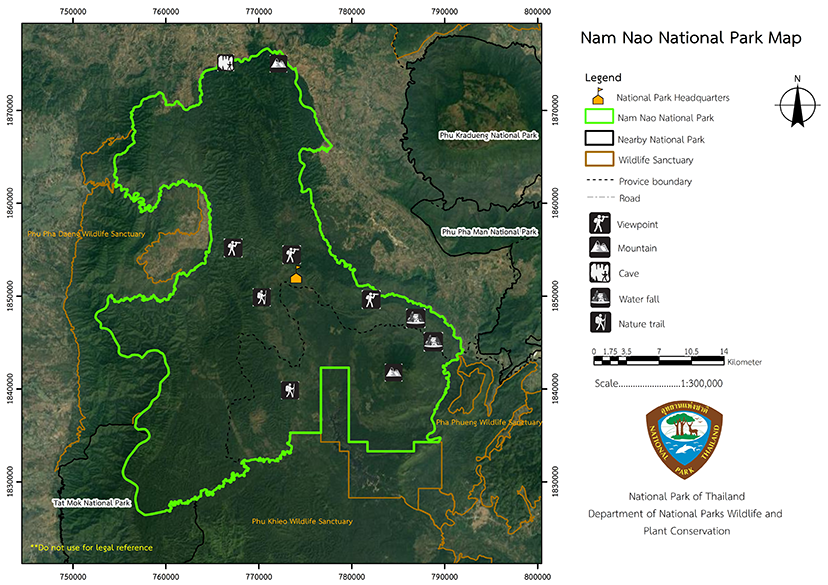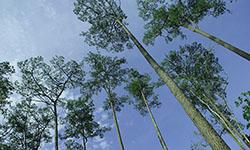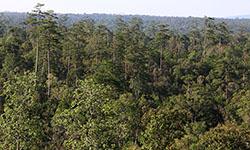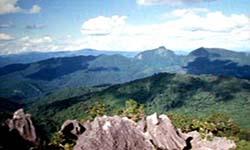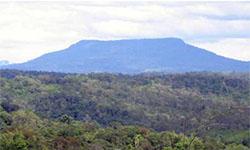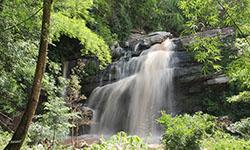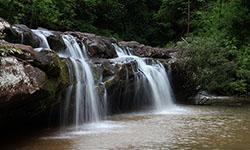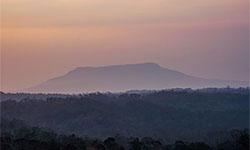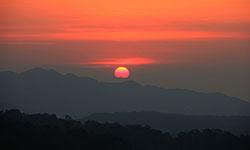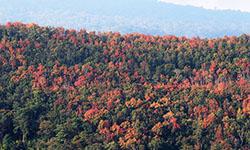Nam Nao National Park
Contact Location : Nam Nao National Park, Nam Nao District, Phetchabun Province 67260
Telephone Number : (+66) 6 1042 8234, (+66) 8 1962 6236
Email : namnao_np11@hotmail.com
Facebook : Namnao National Park
Information
Nam Nao National Park is located in Phetchabun Province's Lom Kao, Lom Sak, and Nam Nao District, as well as in Chaiyaphum Province's Khon San district. It is one of the most stunning National Parks in the country with high mountains demarking the dividing line between the northeast and the north. It has an area of approximately 603,750 rai or 966 square kilometers, fertile forest conditions, waterways, natural scenery, and numerous beautiful places.
Background
On October 7th 1959,the Nam Nao Forest and another 14 foreststhat are National Parks were surveyed. This was followed in 1968 by a survey that was conducted on the Nam Nao Forest area which stated that the forest is fertile with natural scenery, many beautiful places as well as being a habitat for many kinds of wild animals. On May 3rd 1972, following approval in 1970, the Nam Nao forest in the Ban Khok Sub-district, Mueang Phetchabun District, Ban Klang, Ban Tio and Huai Rai Sub-district, Lom Sak District, Nam Nao Sub-district, Lom Kao District in Phetchabun Province and Huai Yang Sub-district, Khon San District in Chaiyaphum Province and the National Park of approximately 966 square kilometers became Thailand’s 5 National Park in the country.
In 1980, the National park division royal forest department issued letter No. Ko So 0708/2214. The head of all National Parks must examine the district's name if it is not included in the National Park responsible for it. Nam Nao National Park has a letter No. Ko So 0708 (No No) / 223 dated March 11th, 1982 which stated that the National Park boundary covers Pak Chong and Tha I bun Sub-district at Lom Sak District in Phetchabun Province as well as the revolutionary announcement No. 142 dated May 3rd, 1972, but did not specify the names of the two districts.
The Royal Forest Department has proposed the National Park Board to have a resolution in meeting No. 3/2523 on October 21st, 1980, approved the issuance of a royal decree to expand the area of the National Park, and additional Sub-district were added to expand the area of Nam Nao National Park in Tha I Bun and Pak Chong Sub-district at Lom Sak District in Phetchabun Province in1982.
Note : After paying the entrance fee to the National Park, please carry the receipt for inspection.
621,250 rai (994 square kilometers)
|
|
|
|
|
|
|
|
|
|
|
|
|
|
|
|
|
|
|
|
Nature trails ⇔ Trekking ⇔ Geological condition ⇔ Observe flowers/plant ⇔ Bird , butterfly , wildlife watching activities ⇔ Stargazing
Welfare shop : 08:30 - 16:30 hrs.
Mobile phone signal :
National Park Headquarters area: AIS, TRUE, DTA
Mobile phone signal :
National Park Headquarters area: AIS, TRUE, DTAC
|
|
Located in the Phetchabun Mountain range, Nam Nao National Park is on the border of Isan and Thailand’s north. The area is bordered by a high mountain range that runs through the provinces of Chaiyaphum and Phetchabun that appears to be an obtuse hill formed by the past elevation of the Earth's crust. Its elevation ranges from 650 to 1,200 meters above sea level and includes Phu Pha Chit, Phu Kum Khao, and the highest peak, Phu Dan I Pong, which is at 1,271 meters above sea level. The area is composed of forests and waterways, and it is a catchment area for several rivers including the Pa Sak River, Pong River, Loei River, the Khon Kaen Creek, and the Nam Chern Creek, all of which flow into the Ubol Ratana and Chulabhorn dams.
|
|
The weather is mostly pleasant during the day and colder than the rest of Thailand throughout the year. It has an the average temperature of 25 degrees Celsius. Between September and October is the rainy season, December and January are the coldest months and are termed winter. In some years, temperatures may drop as low as 0 degrees Celsius.
|
|
|
|
Nam Nao Forest is a large forest that extends in a straight line and it is covered by a variety of forest types. Asthe forest is sparse nterspersed with grassland and evergreen forest water flows all year round. Therefore, this forest has abundant wildlife, such as Wild Elephants, Gaur, Red Bulls, Wild Deer, Banteng, Sambar Deer, Indian Muntjac, Bengal Tiger, leopards, Langur, Asiatic Black Bear, Ursus Malayanus, Serow, wolves, Mouse Deer, Porcupine, , Burmese Hare, Marshall’s Horseshoe Bat, Coelops Frithi, Siamese Large-Headed Terrapin, and the Impressed Tortoise. Indeed, it is one of the best places to spot wild elephants, which are common. In addition, there are more than 200 different types of birds, and along the paths in the forest there are beautifully colored birds such as parrots, Red-belled Blue Magpie, Blue-Tailed Parrot, Broadbill, Thrush, Pittas, Barbet, Woodpecker, Hornbill, Bush Warblers, many insectivorous birds, the Siamese Fireback, and other wild fowls. There are also more than 340 species of butterflies. |
How to get there by car :
The Nam Nao National Park Headquarters is located 103 kilometers from Khon Kaen city in Khon Kaen province, and approximately 55 kilometers from the Lom Sak district, Phetchabun province. To get there, travel along National Highway No. 12 to milestone No. 50th, where there is a sign indicating the entrance to the National Park Headquarters. (From Lom Sak, the signal may be on the left; from Khan Kaen, the sign will be on the right) Continue for approximately 2 kilometers until you reach the Nam Nao National Park Visitor Center. Visitors can find information on tourist attractions, lodges, tents, key pickup, and house rentals, among other things. Visitors arriving by bus can do so from Khon Kaen or Lom Sak, as buses pass in front of the National Park Headquarters daily. It is best to advise the driver before setting off.
Update soon
- National Park Ranger Station No No No. 1 (Tham Huai Pralat)
- National Park Ranger Station No No No. 2 (Sam Bon)
- National Park Ranger Station No No No. 3 (Phu Pha Klang Dong)
- National Park Ranger Station No No No. 4 (Nam Phrom Dam)
- National Park Ranger Station No No No. 5 (Phu Mok)
- National Park Ranger Station No No No. 6 (Yai Nam Nao Cave)
- National Park Ranger Station No No No. 7 (Phrom Laeng)
- National Park Ranger Station No No No. 8 (Phrom Song)
- National Park Ranger Station No No No. 9 (Sam Makao)
- National Park Ranger Station No No No. 10 (Phu Hin Lek Fai)
- National Park Ranger Station No No No. 11 (Huai Rahong)
- National Park Ranger Station No No No. 12 (Huai Mot)
- Accommodation - Nam Nao 104 (Phaya Mai)
- Accommodation - Nam Nao 103 (Saen Kham)
- Accommodation - Nam Nao 102 (Krisana)
- Accommodation - Nam Nao 101 (Thepharo)
- Accommodation - Nam Nao 202 (Ueang Kham)
- Accommodation - Nam Nao 201 (Ueang Ngoen)
- Accommodation - Nam Nao 301 (Phaya Lor)
- Accommodation - Nam Nao 303 (Phoradok)
- Accommodation - Nam Nao 304 (Khun Phaen)
- Accommodation - Nam Nao 305 (Sarika)
- Accommodation - Nam Nao 306 (Saeo Sawan)
- Accommodation - Nam Nao 401 (Inthara Chak)
- Accommodation - Nam Nao 402 (Phuang Malai)

